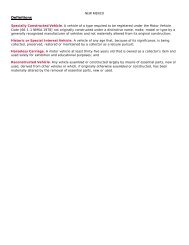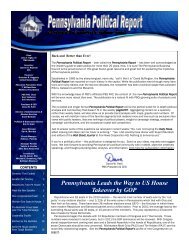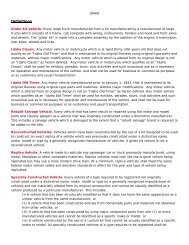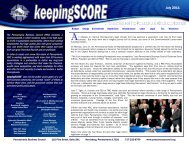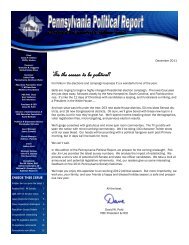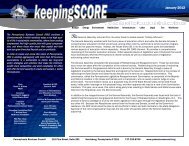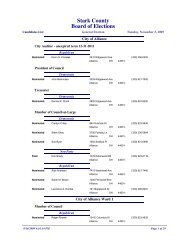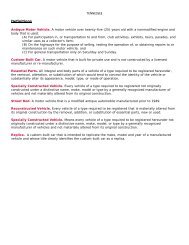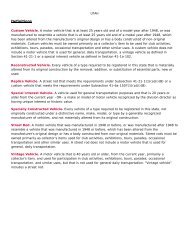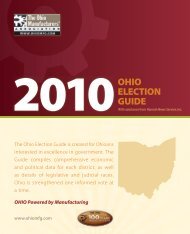LOUISIANA Definitions - BIPAC
LOUISIANA Definitions - BIPAC
LOUISIANA Definitions - BIPAC
Create successful ePaper yourself
Turn your PDF publications into a flip-book with our unique Google optimized e-Paper software.
7. Any after market auxiliary lamp installed on a vehicle's roof or on a roll bar that is designed to emit<br />
white light must be covered when used on public streets and highways. If auxiliary lamps are not properly<br />
covered, the inspector shall reject the vehicle.<br />
I. Parking Lamps on the Front of the Vehicle. When actuated, the front parking lamps must display either<br />
white or amber light. These lamps must operate as originally equipped.<br />
J. Turn Indicator Lamps, Front and Rear<br />
1. Any vehicle manufactured or assembled after December 31, 1962, must be equipped with lamps<br />
which indicate the direction of a turn displaying the signal to both the front and rear of the vehicle.<br />
2. Front Turn Indicator Lamps. Both front turn indicator lamps must be mounted on the same level and<br />
display an amber light, except those vehicles manufactured or assembled prior to January 1, 1969.<br />
Those vehicles may emit either a white or amber colored light.<br />
3. Rear Turn Indicator Lamps. Both rear turn indicator lamps must be mounted on the same level with one<br />
on each side of the vehicle. The lamps may emit either red or amber color light only. The lens covering the<br />
lamp may not be cracked, broken or missing causing white light to be emitted to the rear of the vehicle.<br />
The lens must be of an original type lens.<br />
4. The signal cancellation must operate as originally equipped and cancel the signal when the turning<br />
maneuver is completed, except for truck-tractors, motorcycles or motor driven cycles.<br />
K. Tail Lamps<br />
1. Tail lamps must be covered with an original type lens. It cannot be cracked, broken or missing any of<br />
the lens which would emit white light to the rear of the vehicle.<br />
2. Vehicles manufactured or assembled after December 31, 1962, must be equipped with two tail<br />
lamps.<br />
3. The tail lamp must emit red light only.<br />
4. The maximum height of tail lights is 72 inches and the minimum height allowed is 15 inches.<br />
L. Stop Lamps<br />
1. Vehicles manufactured or assembled after December 31, 1962, are required to have two<br />
operational stop lamps with the exception of motorcycles, motor driven cycles or truck tractors, which<br />
must have at least one.<br />
2. The stop lamps must emit red light only visible at least 300 feet to the rear of the vehicle.<br />
3. The stop lamps must operate as originally equipped.<br />
4. The lens covering the stop lamp must be of an original type not broken, cracked or missing any portion<br />
which allows white light to be emitted to the rear of the vehicle.<br />
M. High Mount Brake Lamp<br />
1. All passenger vehicles manufactured September 1, 1985, and thereafter must be equipped with a<br />
third stop lamp. This lamp is to be mounted in the line of sight near the rear window with at least 4 1/2<br />
inches of exposed red area on the lens. Light duty trucks with the model year 1995 and later are<br />
required to have high mount lamps.<br />
2. The high mount brake lamp must be present and operate as originally equipped.<br />
3. The vehicle shall be rejected if the high mount brake lamp is obscured by any add on item such as<br />
ladder racks, luggage racks, etc. Light duty trucks that are equipped with high mount brake lamps and<br />
have had a camper top installed must have a similar high mount brake lamp installed on the camper top





